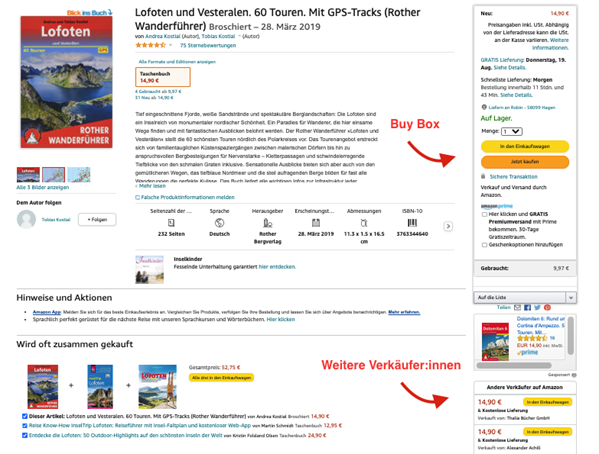Amazon is the largest online marketplace in many countries and, therefore, a distribution channel whose importance can hardly be overestimated. Almost everyone who regularly shops on the internet now have access to an Amazon account – 45 per cent of people who have already shopped at amazon.de use the e-commerce giant several times a month. This is also reflected in the figures: Amazon.de is Germany’s most famous online shop, with a turnover of around 21.33 billion US dollars in 2020. (Source: statista.de)
So, it takes much work to get past Amazon. Those who do not yet sell there are at least well advised to take a close look at the possibilities of the online platform. Connecting Amazon to your own business is hardly comparable to the effort of an online shop. For those who have yet to expand on internationalisation, Amazon also offers uncomplicated solutions.
As simple as the connection should be, the online platform has a few pitfalls. This mainly concerns how Amazon sorts and allocates products. This, in turn, allows conclusions to be drawn about the metrics that salespeople should keep an eye on.
The Buy Box, the Holy Grail
Have you ever noticed that several sellers trade many products on Amazon? Instead of creating a separate listing for each offer, as eBay does, for example, Amazon gathers all sellers of this product on one product detail page. But only one person can receive the sale when a customer buys the product.
Therefore, a complicated algorithm decides who currently “wins” the Buy Box. The small yellow field at the top right of the product page can only be occupied by one merchant who collects the sales. By the way, about 90 per cent of customers buys via the Buy Box. So, the objective must always be to hold the shopping trolley field.

The difference with Private Label
In contrast to commercial goods offered by several sellers, private-label products are goods provided by only one merchant. Mostly, these are smaller brands that belong to the respective seller simultaneously. As there is only one offer, this typically automatically receives the Buy Box.
However, the factors and metrics below are also important because instead of competing on the product detail page, the battle for customers with private labels takes place on the Amazon search results page. It is essential to have as high a ranking as possible here. Or have you ever looked at page 2?
Selling successfully on Amazon: the most important metrics
So, the algorithm is the absolute master on the planet Amazon. Those who know which factors are included in the calculation can improve their business so that they are optimally fulfilled.
1. Fulfilment method
The respective shipping method is of particular importance to Amazon. There is Fulfilment by Merchant (FBM), Fulfilment by Amazon (FBA) and Prime by Merchant. All three have pros and cons. They differ because the seller themselves fulfil FBM and Prime by Merchant orders. In contrast, FBA sellers leave this task to Amazon. They send their goods to the logistics centre of the online giant, which then takes care of everything else.
Of course, this offers the advantage that FBA merchants can sell on Amazon with a small budget because they hardly have to maintain any storage space or staff.
Since Amazon can accurately predict the fulfilment quality with FBA, the algorithm usually prefers this shipping method. Prime status, which is immensely important, is included. In contrast, FBMers can only acquire this logo by invitation and after extensive testing.
2. Shipping time
In Germany, at least, the expectation of receiving online orders as quickly as possible has taken hold. Amazon customers, in particular, are very spoiled by the Prime programme in this respect. Delivery times should therefore be within one or two days to positively affect the algorithm.
Since with Fulfilment by Amazon, shipping is handled by the e-commerce giant, FBA sellers don’t have to worry about this, but FBM sellers do because they have to set up their fulfilment processes themselves in such a way that they limit the shipping time to a maximum of two days.
3. Final price
Unsurprisingly, the selling price is vital in determining which seller gets the Buy Box with their offer. A common legend says: The lowest price wins. But that is, at best, only half the truth. Amazon sets a specific price range within which offers qualify for the shopping cart field. Above or below this, the buy box can no longer be conquered. However, this range leaves more room than most sellers believe.
That’s why it’s so important to set the proper focus on price and to keep testing out what scope a product has. This can hardly be done manually, as traders would have to constantly monitor their competitors and the general market situation, adjust the price of each product several times a day and react directly to fluctuations.
Therefore, it is common to hand over this task to a repricer. It is essential to use dynamic, intelligent software like SellerLogic Repricer instead of relying on the rigid rule optimisation of many simple tools. Because the latter produce only the lowest price, leading to price wars and price erosion.
On the other hand, dynamic tools can even help raise Amazon’s internal price range by repeatedly testing how high the price can go before the buy box is lost. Suppose the product prices are at the upper edge of the range for a specific time. In that case, this can lead to Amazon correcting them accordingly.
4. Seller performance
It should be no surprise that Amazon monitors and evaluates its marketplace merchants at all times. This factor, known as salesperson performance, is made up of many parameters, all of which are beyond the scope of this blog post. We have therefore summarised the best-known key figures in the table below.
| Key figure | Definition | Ideal value for winning the Buy Box |
| Rate of order defects | Negative feedback rate plus A-Z guarantee request rate plus cancellation rate | 0% |
| Cancellation rate before order processing (in %) | Orders with cancellation divided by total number of all orders | 0% |
| Rate of valid tracking numbers | All deliveries whose shipment status can be tracked | 100% |
| Rate of delayed deliveries | All deliveries that were delivered later than specified | 0% |
| Rate of on-time deliveries | Deliveries that were delivered on time | 100% |
| Dissatisfaction with returns (in %) | Number of negative return requests divided by total number of all return requests | 0% |
| Seller rating and their number | Total number of ratings the seller has received | The higher, the better |
| Response time | How long does it take for the seller to answer customer queries? | < 12 hrs. |
| Inventory | How often the seller has no stock | The rarer the merchant is out of stock, the better |
| Dissatisfaction with customer service (in %) | How often customers were dissatisfied with a response from the seller | The lower, the better |
| Reimbursement rate | How often customers ask for a refund | The lower, the better |
Conclusion: few hurdles, but not undemanding
It’s relatively easy to get started with Amazon. If you use FBA, you can send your goods to a logistics centre without having storage space or a workforce ready to handle orders. Instead, Amazon takes care of all the fulfilment. Nevertheless, Amazon as a marketplace should not be underestimated – adherence to the high standards as far as customer service is concerned must be studied and adhered to achieve sustainable success.
These include, in particular, the shipping method and duration, the final price and the general performance of the merchants. If the metrics are not right here, it can become impossible to win the Buy Box or achieve a good ranking in Amazon search.






